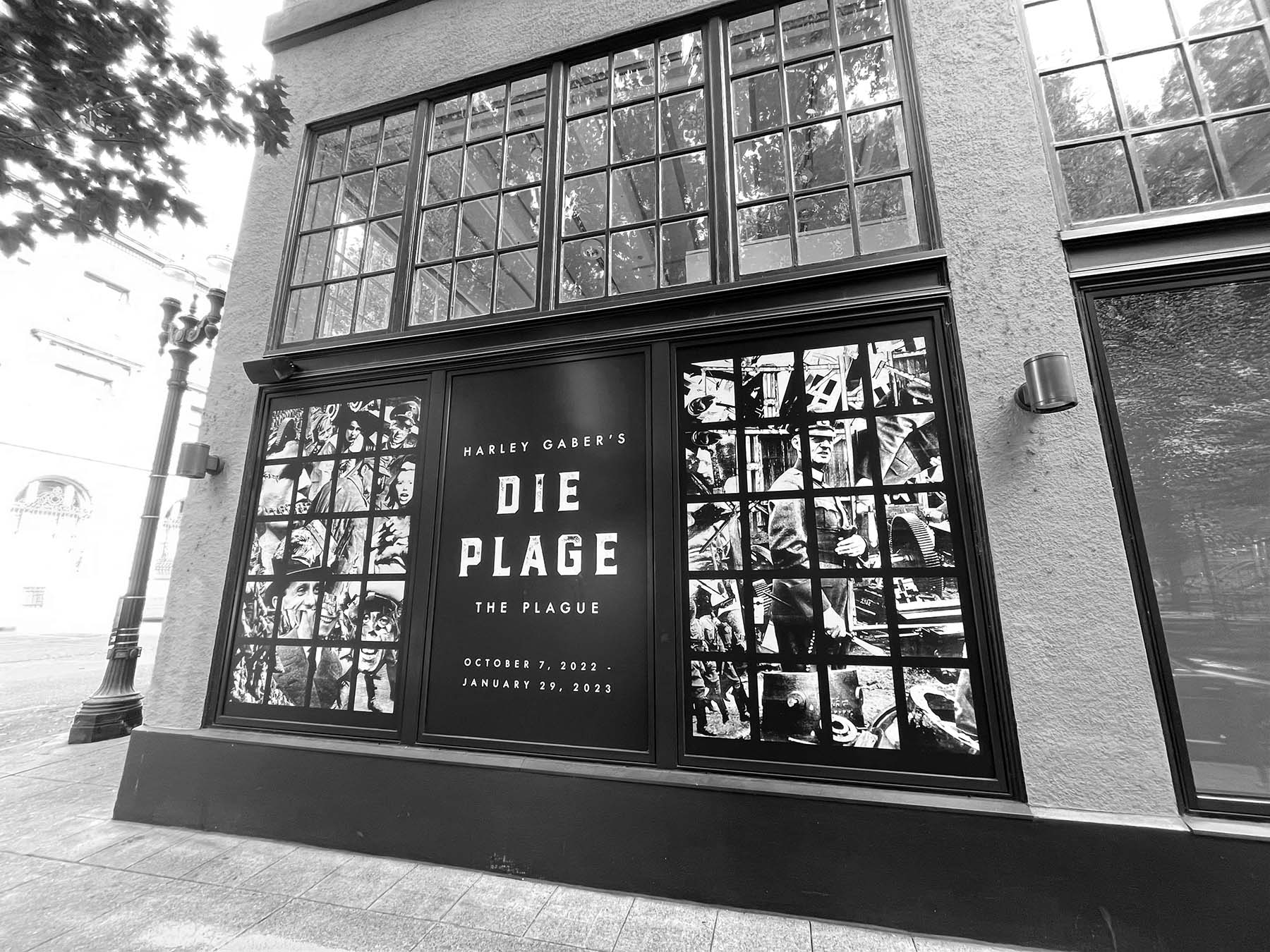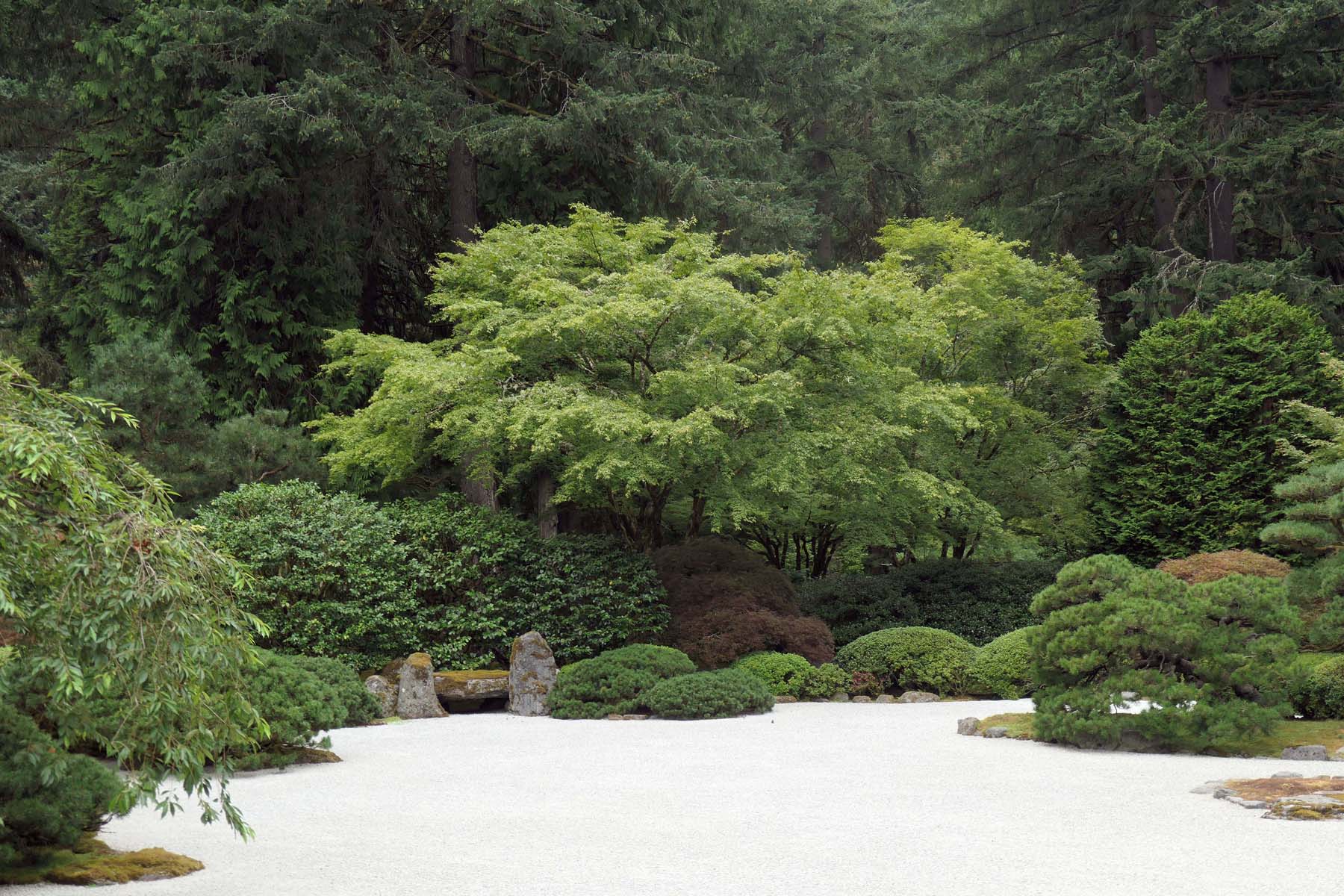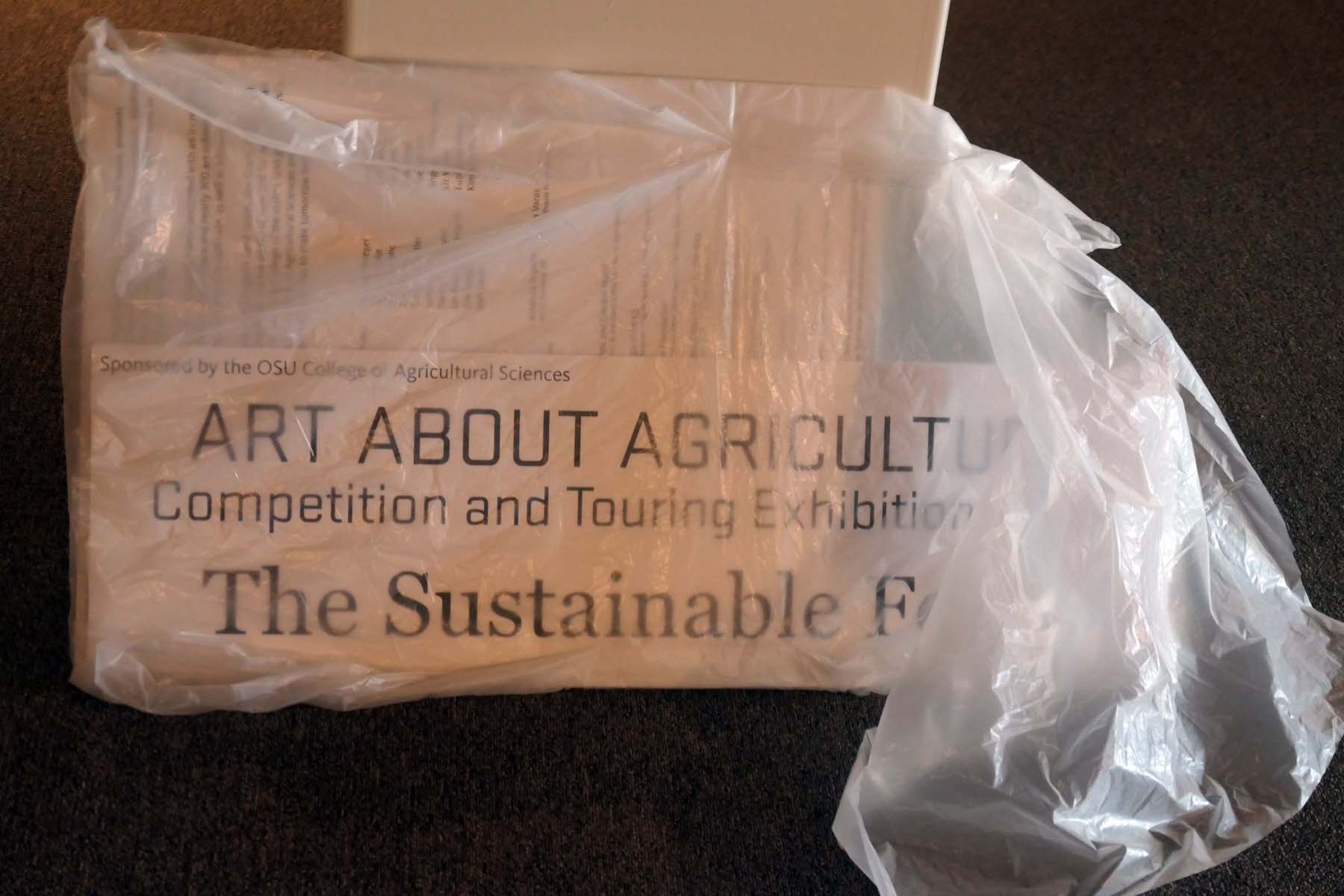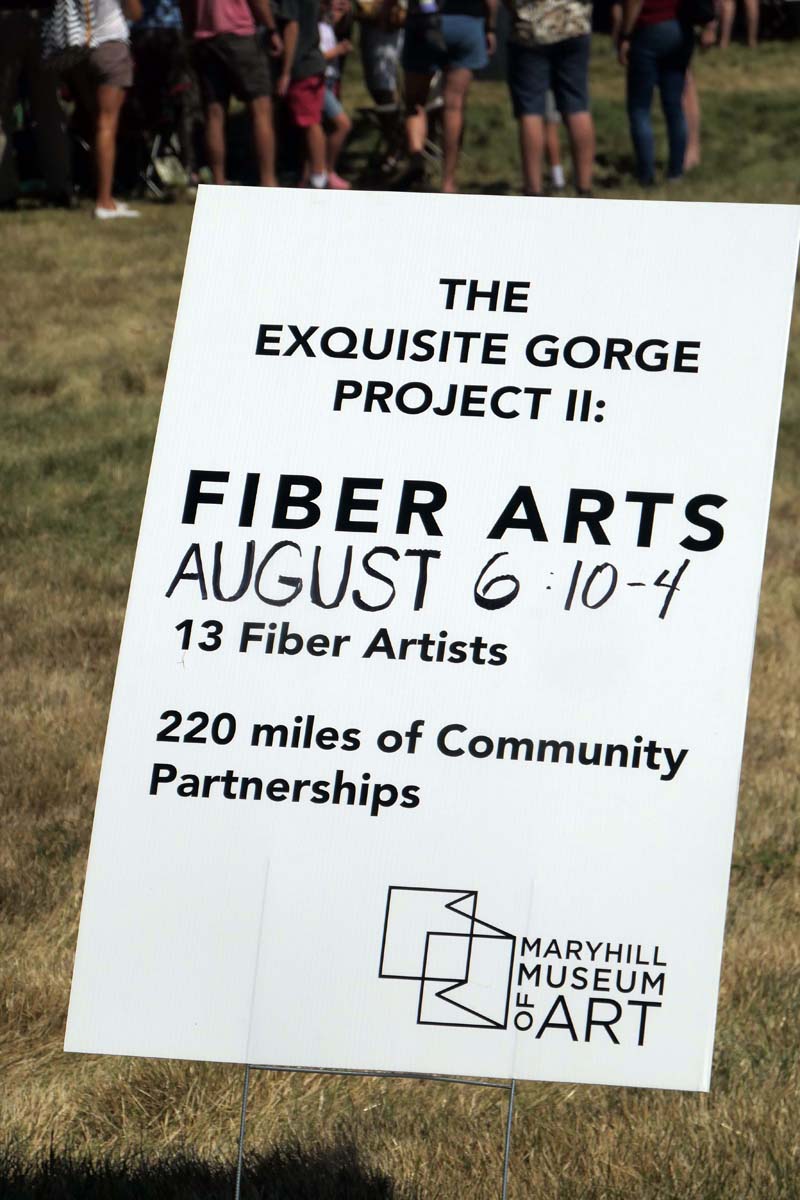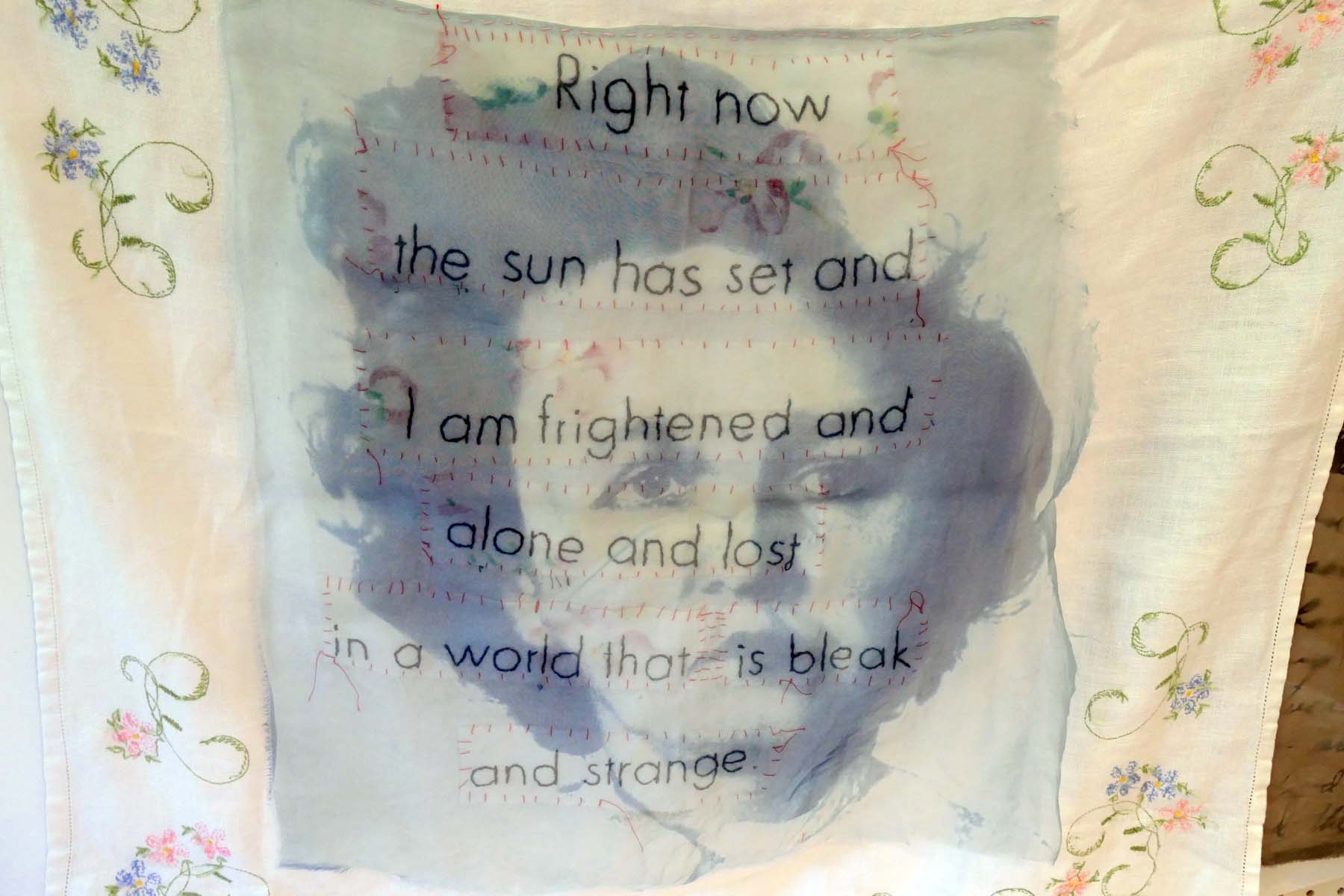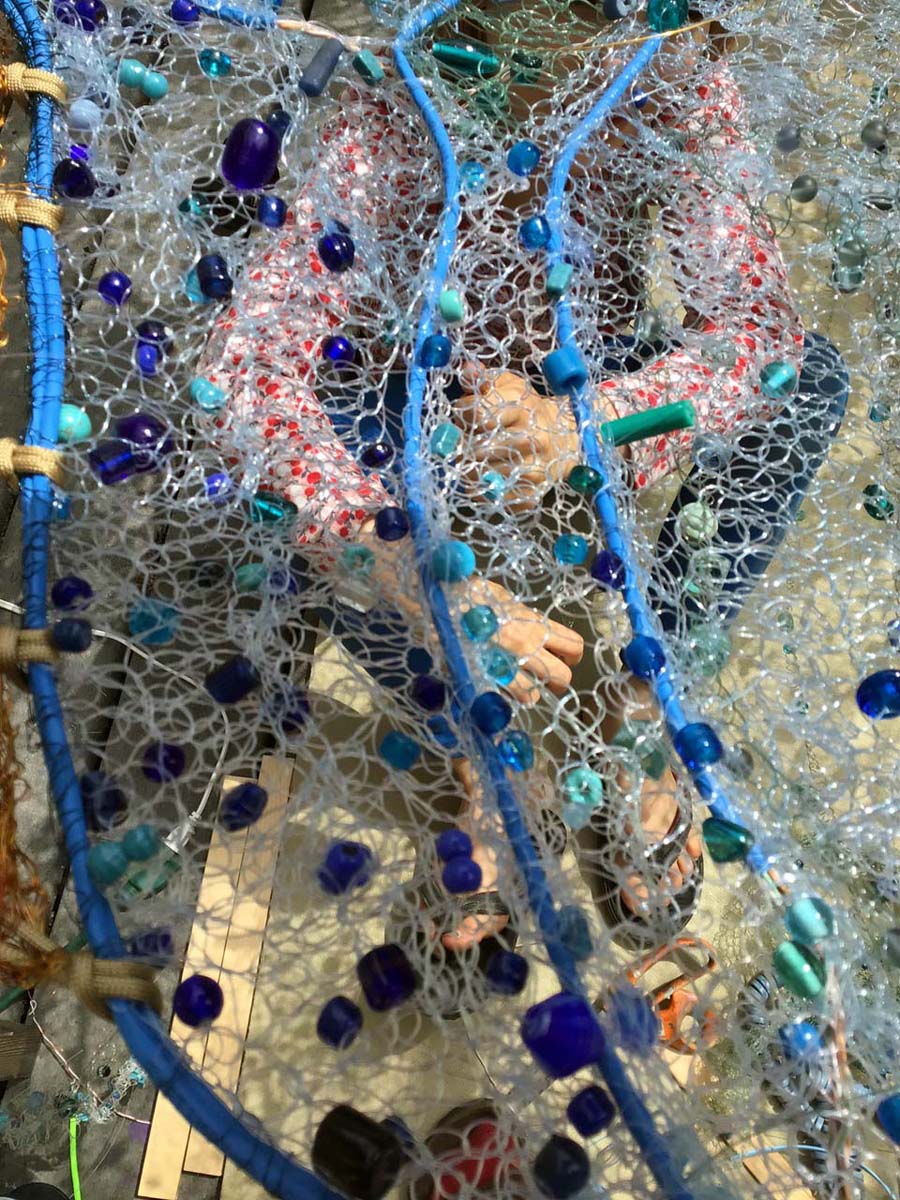Die Plage (The Plague)
· Harley Gaber at the Oregon Jewish Museum and Center for Holocaust Education ·
In memory of Alice Meyer (z”l) who fought the rising dark forces to the end.
Tiresias:” You mock my blindness? Let me tell you this: You with your precious eyes, you’re blind to the corruption of your life, to the house you live in, those you live with – ” (415) – Sophocles Oedipus the King, translated by Robert Fagles.
DO YOU REMEMBER the unfolding of this famous tragedy? A priest implores the mighty Oedipus, the king of Thebes who rescued all his people once before, to stop the plague that’s ravaging the land. The ruler eagerly agrees, but when he starts intuiting the truth that after all might save them, he does not want to see it – just as the blind prophet Tiresias, who knows and was commanded to reveal it, has trouble naming it for fear of wreaking havoc. The truth, once it’s acknowledged, will lift the plague but also devastate the king, and his desire to remain unseeing does end up leading to his ultimate demise, including gouging out his eyes himself. Blind, after all, for real.
Perhaps you share with me a sense of needing to protect ourselves from ever more bad news, unending, constant, one development more dire than the next. It feels like our sanity depends on turning our eyes and ears away from yet more fear-inducing bits, just like the king of Thebes. Pandemic(s), the rise of authoritarian regimes drifting into fascism, wars and the ultimate threat to our existence, the devastation of our planet through self-inflicted climate change: plagues, all.
So why expose yourself to looking at depictions of the Holocaust, no matter how compelling, how educational, how directly speaking to the human heart? Won’t looking at the Oregon Jewish Museum and Center for Holocaust Education‘s current exhibition, Harley Gaber’s Die Plage (The Plague) depress us even more?

We must. We must engage because we’ve known since Ancient Greece, if not before, that blind passivity does not end well. We must, because the medium that carries the message, in this case walls and walls of 390 assembled, collaged, sometimes manipulated archival photographs from 1918-1945 Germany and other objects, is more effective than a thousand words or numbers. It conveys that plagues will haunt us unless we fight them and uproot the seeds that have been lying fallow, not destroyed. And if you argue I should skip the guilt trip, since all your life you’ve faced the issues of the Holocaust to utmost saturation, I get it, but I disagree.
The only way to fight the plague is to name, to depict and educate. It requires from all of us a willingness to be confronted with the history, our part in it, its implications for the world we live in right this moment. Even when looking is hard.
A close inspection of Gaber’s installation might reveal some parallels to social and political developments right here and now. It reminds us how authoritarian mindsets are fostered and how right wing structures are organized from scratch, with the support of protofascistic organizations. We live in a time where authoritarians get increasingly elected into office internationally, like Meloni in Italy, Orban in in Hungary, Erdogan in Turkey, Duterte in the Philippines, Putin in Russia or are hovering in the wings, like Le Pen in France, the Partij voor de Vrijheid, (party for Freedom) PVV in Holland, and the Sweden Democrats, a right wing, Islamo-phobic populist party that won in recent elections as part of a coalition with centrists. Yesterday holocaust survivor #LilianaSegre (a victim of Mussolini’s race laws) handed over the Presidency of Italy’s Senate to Benito La Russa, a man who wants to be an heir to Mussolini, gives the fascist salute, and collects fascist memorabilia.
Just last weekend, the far-right AfD (Alternative for Deutschland) doubled their votes in state elections to over 10%. One of their politicians, Holger Winterstein, publicly danced on the slabs of the Holocaust Memorial in Berlin this week, spouting phrases about the rebirth of the German Volk.

Memorial to the Murdered Jews of Europe, Berlin – Photo Friderike Heuer
Many characteristics of fascism can be found in the platforms of all of these leaders, including racial purity as a basis for national belonging, a fear of White-replacement, anti-feminism, a cult of leadership and worship of the military, a rebirth narrative, suspensions of democratic freedoms, and attacks against the press. I need not spell out how all of this applies to what is going on closer to home.
***
“Perhaps the belief that consciousness permeates everything and transcends – by that I mean encompasses – the cyclic nature of living and dying, would allow us to accept the inevitable beginnings and endings of things as part of a meaningful continuity, not just a tragic aberration” – Harley Gaber, September 2010 as related in the Interviews by Robert Reigle.
HARLEY GABER (1943 – 2011) was born in Chicago into a Jewish-American family. Until the 1970s he was trained and worked as a composer, studying with Horace Reisberg in high school, then Kenneth Gaburo at the University of Illinois, Champaign-Urbana, and later Darius Milhaud, among others. His minimalist work is hailed as among the most distinctive of post-World War II American music. (The link leads to a detailed review of the artist’s music.)
His interest in artistic abstraction had started early with a fascination of Jackson Pollock’s painting, which he claimed influenced his music. So did Morton Feldman‘s elegant 1963 chamber work dedicated to the painter “De Kooning,” by all reports. The cross-over between music and visual art was present then, from the beginning. So was the tendency, in both art forms, to alternate between sparseness – compression, exigence, selection – and abundance, with the former more characterizing the music, the latter the visual onslaught of the montage motifs. Major compositions include Sovereign of the Centre (1972-74),The Winds Rise in the North: String Quintet (1974), I Saw My Mother Ascending Mt Fuji in 2009, The Realm Of Indra’s Net and In Memoriam 2010.

Harley Gaber in front of one of his photomontage panels in 2000 – Photo courtesy of Christina Ankofska
In the late 1970’s Gaber moved from NYC to California, leaving music behind for a time, devoting himself to playing and teaching tennis, taking care of his aging parents, and eventually the montage work across a decade that resulted in Die Plage. Several trips to Germany were undertaken for archival research and exploring historic places, Weimar and the concentration camp Buchenwald memorial site in Weimar’s suburbs, among them.


KZ Buchenwald Memorial Site – Photos Friderike Heuer
By 2002 he returned to composing, as well as some forays into film-making. His view of music shifted in perspective, former technical musical tools and conceptualization of consciousness replaced by a focus on the complexities of the heart. In a profound crisis, wrecked by insomnia, he took his own life in 2011 two weeks after his last composition, In Memoriam 2010, was published, a piece commissioned by the Dan J. Epstein Family Foundation, dedicated to Nancy Epstein, who passed away in 2010 and was a close family friend of the Gabers.
***
“Eine neue Kunst muss endlich angeben müssen wozu sie gebraucht werden will. ” (It’s about time that a new form of art declares what it wants to be used for.) – Berthold Brecht, Schriften zur Literatur und Kunst.
FOR SOMEONE INTERESTED in quantum physics and in the art of the Weimar Republic, as Gaber was by all reports, photomontage seems ideally suited as a visual medium. The combination of intimate scale and monumental extent, with ever smaller units affecting each other across space, in some ways mirrored his approach to musical notation. He drew parallels between our insights from physics to how he perceived humanity to function. In quantum entanglement you cannot describe the state of one of the quanta without the state of the other one. They can only be apprehended as a unit, even if they are far apart. Gaber’s montages gave visual life to this concept: the distinct groups of a society only to be understood in their linkage to each other. Perpetrator and victim, oppressor and oppressed part of the same system under the umbrella of a deadly ideology.
Photomontage basically refers to collaging with photographs, creating new and different wholes from altered parts, telling a story. It used to be a dark room, paper, scissors and glue affair. These days computer technology allows seamless merging and alteration of digital images where all evidence of historical reality of the components disappears. At the heart of it is fragmentation and construction, playing with perspectives that encourage or prevent a subject’s visibility. The use of scale can obscure – sometimes smaller segments can distract from the larger picture, sometimes grand expansions blur your ability to see detail. Visibility, of course, will matter only if you are inclined to look. The switching back and forth between micro, macro or intermediate levels can be in itself demanding.
Then there is the matter of representation: who is represented, how do we represent? Are we manipulated by caricature, or surreal additions, by use of symbolism and/or text? If our hold on reality is ridiculed by including absurd juxtapositions, are we turned off enough to turn away? The question every artist needs to struggle with is how to represent a topic so over-saturated in visual memorial culture like the Holocaust. How do you prevent archival photographs of boots and soldiers, trains and camps and swastikas in endless repetition from being seen as overly familiar tropes, sparking associations only to a concept, safely relegated to the past?
In Europe between the wars, photomontage techniques were used by many artists who were part of the Dadaist movement, protesting against the First World War. The surrealists soon grasped this tool that lent itself to their exploration of consciousness and free association – with quite a few women as path breakers: Emila Medková, Claude Cahun, Dora Maar, and Hannah Höch. But the real surge of photomontage could be seen when first Russian constructivist artists applied it regarding issues of social justice and then the Neuer Deutscher Verlag (New German Press), run by Willi Münzenberg, committed itself to photomontage as a propaganda tool, most famously in its flagship periodical Die Arbeiter-Illustrierte Zeitung (or AIZ) (Worker’s Illustrated), which it began publishing in January 1925. By 1930, artist John Heartfield, clearly a model for Harley Gaber, began to contribute his intense montages to the AIZ, attracting yet more readers. The new art form had signaled its intentions: agit-prop.
In 1931, one of my favorite montage artists, César Domeal-Niewenhuis, curated the very first exhibition devoted solely to the new art form – Fotomontage – under the aegis of the Berliner Kunstbibliothek, in Berlin. Raoul Hausman opened the event, and the montages were displayed in sections divided between advertising and political art, with John Heartfield and the Bund revolutionärer bildender Künstler Deutschlands (The league of revolutionary German visual artists) dominating those exhibits. Experimental works by Lászlo Moholy-Nagy and Hannah Höch, among others, had their own corner. I do not know if Gaber saw the catalogue or was familiar with this work, but it likely would have resonated. A fascinating retrospective of the history of art during the Weimar Republic opened in Berlin at the Staatliche Kunsthalle in 1977 – Wem gehört die Welt: Kunst und Gesellschaft in der Weimarer Republik (Who owns the World: Art and Society in the Weimar Republic). It might have been an impetus for Gaber’s new dedication given that the exhibition focused on the ways in which the artists related to the people, how they attempted to contribute to changing the world and how those actions were received. The anti-war photomontage work of his U.S. contemporary, the brilliant Martha Rosler, devoted to exposing the failure of our political class to learn anything from history, might also have been of interest to him. We will never know.
Then again, the desire to create this monumental work might have come from a uniquely Jewish-American perspective trying to map the universal principles that emerge when humans embrace or are exposed to the maelstrom of ideology and desire for dominion. By deconstructing the specifics of that moment, or of the era that produced the horror, Gaber hoped, perhaps, to lay bare mechanisms that translate generally. As a humanist he certainly acknowledged the agency of human beings, respecting moral values, but was also quite aware that living up to our potential is contextually shaped.
***
“Here the ten plagues will be enumerated, and it is a widespread—though not particularly old—custom to remove a drop of wine from the cup for each plague. This strange practice was explained to me, when I was still a boy, that wine is a symbol of joy, and because each plague caused our tormentors to suffer on our account, the joy over our own liberation is diminished…Whether this explanation may make claim to historical truth may remain unanswered, but one must recognize the poetic truth in it, because it breathes the spirit of Judaism.” Rabbi Eduard E. Baneth Der Sederabend: Ein Vortrag, (A Lecture on the Pesach Seder) published in Berlin in 1904.
ONE OF THE HIGHLIGHTS of the Passover Seder is the recitation of the plagues sent by G-d to punish the Egyptians who enslaved the Jews – that is if you share the table with young kids. With glee and abandon they dip their fingers, fling the drops of grape juice, yell the names of the afflictions, vermin among them. (Bonus: throwing the plastic frogs and locust used for decoration at each other.) The plagues seem far away, the threats averted. But much history is learned during this annual event, oral transmission linking generation after generation.
Harley Gaber did not grow up around a seder table, the household culturally Jewish, but he intuitively understood the role of children in societies that try to relate their history and, for some, keep their power hierarchies intact.

The montage display contains numerous single images of children and also groups them in ways that form more cohesive narratives. You have the (pre)-teens of the Hitler Youth right next to their Jewish age mates, ready for the trains to be transported. The uniforms of the Hitler Youth (an early unit of the Storm Troopers, mandatory participation for all youth) prepared for the soldierly character of the NSDAP, signified in-group membership, and conferred status. They had to be bought by the parents and many boys were keen on them, thinking it was cool. Children learn the values early, but also understand the power distribution, growing right into docile and willing soldiers, as long as they are not the bottom of the heap.



Top and bottom, after all, a major concept in fascistic thinking, which denies the truth that all of us are equal. In their twisted ways, race, religion, gender, sexuality, physical and mental health were markers of the hierarchy. The spatial word “unter” (below) an important suffix for power relations: there was the Untertan (imperial subject,) the Untergebene (subordinate) and eventually the Untermensch (subhuman), denying Jews and Roma their humanity.
One of the prominent texts in Gaber’s installation reads: “Wir fahren nach Polen um Juden zu versohlen.” (We’re traveling to Poland to give the Jews a good hiding.) The German verb is mostly used in the context of teachers beating their students, something children could easily comprehend. Now they weren’t the targets, but someone else was. It was not just the teaching that violent persecution of minorities was ideologically justified. Children learned early on that hatred, anger or resentment – the whole range of anti-humanistic feelings – were acceptable and even desirable, as long as they found their targets in convenient scape goats. Rote expression of loyalty in these paramilitary youth camps eventually turned to the real thing. Belonging felt good, de- individuation in those group settings eased remaining conscience.

Wir fahren nach Polen um Juden zu versohlen
Parallel to spending afternoons and evenings in these organizations (divided by age groups and gender,) indoctrination became part of the school day as well. It was not just what was NOT allowed to be read or learned, (book banning, anyone?) but importantly how curricula and instruction materials were centrally under the complete control of the party apparatus, as were the hiring and firing of (dis)loyal teachers and professors. Education was no longer geared towards the development of personality and learning, but forced the kids to put on mental blinders, uncritically digesting what was offered, a reduction to the atavistic stages of development. I see Harley Gaber’s work as enormously prescient in that the indoctrination of youth, so prominently displayed in his montages, is to be feared, and easily accomplished when education becomes usurped by those in power and ideologically or religiously driven. We see it, here and now.
***
“The purpose of art is to lay bare the questions that have been hidden by the answers.” – James Baldwin, The Price of the Ticket: Collected Nonfiction, 1948-1985
GABER’S INSIGHT about the interconnectedness of a nation’s strata can be found in his depictions of ordinary Germans going about their lives in union with the rising fascists, as well as conservative politicians, who engaged in Faustian bargains with the Nazi representatives in order to hold on to power. At least that was my interpretation, thinking that perhaps one of the photographs portrayed Kurt von Schleicher, the last chancellor of the Weimar Republic, eager to keep oversight over the military and appeasing his rival Hitler, eventually murdered by the Nazis during the Night of the Long Knives.

Top row, 6th panel from the left – portrait of someone reminding me of von Schleicher.
We often forget that during the rise of radical forces more moderate political parties are willing to form alliances with them in order to achieve or stay in power, with the strong belief, if one is generously speculating, that they might keep them in check and under influence within their power arrangements.(A good introduction to this topic can be found here.) That certainly was the case with Hindenburg and Hitler, or Emperor Emanuel and Mussolini, catastrophic miscalculations, both.
Just looking at the current gubernatorial race in Oregon, we have reports that one of the candidate has tied herself to “multiple far-right extremists, including a militia leader, a financial backer of the January 6th insurrection, and a Q-Anon conspiracy theorist.” Another one is reported to have sought the endorsement of the Timber Unit, a group full of extremists, and accepted their award. She lamented to The New York Times: ‘You can see the deterioration of the beautiful City of Roses, now the city of roaches.’ Some people have interpreted that as a de-humanizing reference to Portland’s many unhoused people (a claim denied by the candidate), and a dog whistle to the far right that calls them pests. Roaches. Pest. Plague.
It is not only politicians, though. When celebrities, like Kanye West this week, spout unequivocally anti-Semitic statements on Twitter to their 30 million followers (there are roughly 14.8 million Jews alive) and are welcomed to the platform by the richest man in the world in short succession, it opens more space for resonance for poisonous beliefs and strengthens those who already agree. In Germany, 36.000 people marched in the state of Thuringia alone, at the beginning of October, called by the AfD to protest political conditions, with far-right extremists joined by many ordinary citizens in fear of deteriorating economic conditions due to the war in Ukraine and other political decisions around immigration and environmental protection. When right-wing extremists take to the streets together with the supposedly “middle class,” when there are no longer any fears of contact, the citizenry acts like a sounding box for the Neo-Nazis, amplifying the message. It normalizes anti-democratic positions. Harley Gaber warned us.
***
“Memory, the mind’s power of having present what is irrevocably past and thus absent from the senses, has always been the most plausible paradigmatic example of the mind’s power to make invisibles present.” –Hanna Arendt, The Life of the Mind (1977)
HARLEY GABER’S PHOTOMONTAGES attempted to make the invisible present through creative juxtapositions. He was keenly aware that only testimony, in this case a visual, constructed epic, can keep the past and its lessons alive. In that way, this installation could not be more timely for Jewish museums and institutions in a day and age where the memory of the living is receding, given that the last survivors of the Holocaust are passing on. Memory can only be kept maintained, if we transmit it, true for German and U.S. history of fascism alike. We owe a debt of gratitude to individuals as well as organizations who engage in that task.


From left to right: Melissa Martens Yaverbaum, Steve Gaber, Harley’s brother, Christina Ankofska. Harley Gaber installing one of his panels. photo on right courtesy Christina Ankofska.
After Gaber’s death, his friend Dan Epstein, President of the Epstein Family Foundation that sponsors this exhibition, and Steve Rees, a close friend of the Gaber family, organized the preservation of the work. Much time and resources went into digitizing, cataloguing and storage of 4.200 (!) montages (the 390 on exhibition are a subset based on prior selections by the artist.) This will enormously help curations of this body of work in the future.
Alerted by an article in the NYT about new and diverse approaches to Holocaust and genocide education at Jewish museums, Epstein and Rees (the co-manager of the project) approached a number of them to discuss the possibility of exhibiting Gaber’s work. OJMCHE, under the leadership of Judy Margles, decided to host the project. Margles was able to secure the talents of Melissa Martens Yaverbaum, Executive Director of the Council of American Jewish Museums (CAJM) to act as guest curator who extended the scope of the project beyond the photomontage work. You will find interesting materials that allow glimpses of the musician and philosopher as well. Yaverbaum, in turn, received support from Gaber’s brother Steve and Harley’s former partner Christina Ankofska in exploring the art and life of Gaber.
Christina had accompanied Gaber on one of his research trips to Germany, and was present for much of his work creating his montages and preparing them for one of the few exhibits he lived to see. She told me a story that she thought encapsulated his humanism, as much a part of him as were his visionary and creative talents. They left the installation of Die Plage in L.A. (LA Times review from the year 2000 here,) long after midnight, starving. Miraculously they came upon a hot dog cart, amidst a group of unhoused people. Gaber decided: “Hotdogs for all!” and they found themselves happily gorging in famished company now generously treated in the early morning hours. A Mensch, in other words, whose memory should be a blessing. It is up to us to keep his memory and that of all who perished under fascist rule, alive. Gaber’s montages will be of great assistance in that effort.

Memorial marker at the concentration camp Buchenwald memorial site. Part of the inscription for the victims, women and girls in this case, reads: “But you live as long as other humans keep you in their memory.” Many other markers are spread across the site for specific groups of victims. NON OMNIS MORIAR – I shall not wholly die. Photo Friderike Heuer
____________________________________________
Harley Gaber: Die Plage
October 7, 2022 – January 29, 2023
OREGON JEWISH MUSEUM AND CENTER FOR HOLOCAUST EDUCATION
724 NW Davis Street
Portland, OR 97209
Wednesday – Sunday: 11am – 4pm
